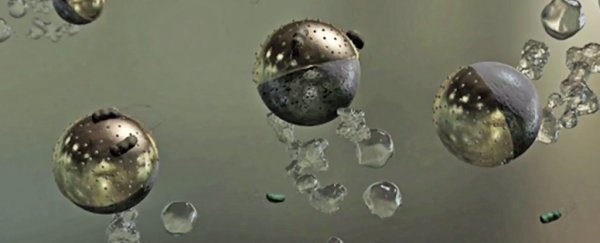Scientists have unveiled spherical microbots capable of propelling themselves through water and killing off bacteria at the same time, potentially giving us a new and effective way of tackling contaminated water supplies.
Swimming through water infected with E. coli, the new bots were able to kill more than 80 percent of the bacteria present inside 20 minutes, and because they're magnetic they can be easily pulled from the water too.
That's a big advantage over adding cleaning chemicals to water, chemicals which stick around after use and may not be very effective, according to the team from the Max Planck Institute for Intelligent Systems in Germany.
"One of the most persistent problems affecting people throughout the world is inadequate access to clean water," write the researchers. "Therefore, there is an urgent need to develop more effective, innovative, low-cost, robust water-cleaning methods, which do not adversely affect the environment or damage human health."
Enter the microbots, based on the 'Janus particle' bots developed at Max Planck last year. Like those bots, the new ones are divided in two – one half is made of magnesium, which creates hydrogen bubbles in water and acts as a propulsion system.
The other half is made of alternating iron and gold layers topped off with silver nanoparticles, and acts as the bacteria-blasting part of the mini machine. The iron and gold layers trap the target bacteria, and the nanoparticles kill them off.
It's the iron that enables magnets to draw out the microbots after they've done their cleaning duties, along with the trapped, dead bacteria, because you don't really want to be drinking or swimming around in water that's packed with microbots.
The more bots that get added, the more effective the cleaning is likely to be, say the researchers, although an 80 percent clean up rate is pretty impressive already.
With around 663 million people in the world living without clean drinking water, the bots are a promising option for places where electricity is scarce and funds are low, though we don't know yet how long it might be before we see them in action out in the real world.
There's plenty of strong competition when it comes to miniature water-cleaning robots, as well: we've previously seen a robot that can produce its own electricity and clean up water pollution as it moves across water.
Last year, meanwhile, an international team of researchers developed graphene-based nanobots capable of pulling lead out of wastewater quickly and efficiently. Of course if we were a little kinder to the planet we might not need so many of these inventions.
The researchers behind the new bot are promising to continue working with and refining their creation: they say the bot is "biocompatible, environmentally friendly, and does not produce chemical waste during and after operation".
"Thus, the combination of active systems and nanomaterials to develop new micro and nanomotors can open new horizons for demanded medicinal, energy and environmental applications," the scientists conclude.
The research has been published in ACS Applied Materials & Interfaces.
There's also a video showing the bots in action, which you can see below:
